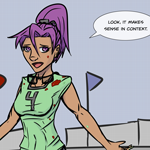Magic
Eidos:
Eidos is an ancient philosophical term; loosely speaking, it means the information that makes up an object we then perceive through the material world. When we see something – for example a chair – we see the manifestations of it’s properties – we see wood, four legs, we can even estimate weight, height, velocity, and thousands of other conceptual variables we cannot see. Eidos is where all those variables are defined. The material manifestation directly effects Eidos – if you kick a chair, you suddenly add directional acceleration to it, and you may even – depending on it’s properties of durability – break it into different objects.
The opposite – the altering of somethings properties in Eidos effecting the material form – as it turns out, is also true. This is what we call Magic.
Magic:
At it’s core, Magic is altering the properties of something in Eidos without using it’s material form as the medium for change. Take a tennis ball. You could accelerate it by hitting it with a tennis racket. You could also accelerate it by adding velocity to it’s Form in Eidos; since Eidos directly impacts how the material world works, the ball would sudden accelerate to the modified velocity.
There are three main guidelines:
- First, changes that do not make sense by material physics cease when the interference of magic ceases. The ball will not continue to defy friction and gravity, nor will it defy conservation of motion; if the ball is in the atmosphere, it will slow down and eventually stop, just as if you’d hit the ball with a racket. However, if you can make a ‘stable’ change, there will be nothing to revert – for example if you destroy a rock to pebbles, the pebbles will not reform into the rock, as pebbles are consistent within the system of reality.
- Second, while altering Eidos ignores conservation of mass and energy (just as cheating in a video game would bypass the physics engine); it is not an unlimited power. The greater the change violates the rules, the harder it is to make.
- Third, changing Eidos requires Mana (the IDS refers to Mana as ‘psionic particles’). The nature of this energy is poorly understood, and directly interacting with it is challenging.
The greatest problem with Eidos – and for that matter mana – is they, by definition, are not part of the material world; there is no direct way to interact with them, and thus the actual mechanics of how a mage works magic is unknown – the conceptual leap from understanding that Eidos exists to understanding how to change it is what makes someone a ‘Mage’
Mages:
There are three types of mages:
Innate Mages: Innate mages are people that can use magic, usually one specific magic, without having to use any conscious calculation; they can move directly from an actionable thought to realizing the magical change. This can roughly akin seeming to have a super power. Most innate mages are also natural mages, but they are frequently more limited then someone that is ‘just’ a natural mage in using magic outside their innate talent.
The most common type of innate mage is those that can alter their own properties, like strength, speed, and durability, but the innate ability can be far more unique.
Natural Mages: Natural Mages are those that can conceptualize calculations, leveraging their Eidos Key to realize magical changes onto the world. This typically requires extensive study to be able calculate the necessary stable change that actually works. A moderate percentage of the population can be trained to be natural mages, but it is by no means easy, and number decreases the later the training starts, with many who can be trained never reaching the ability that would be useful in combat situations.
AutoCaster Users: People that are not capable of fully calculating stable changes in the conscious mind were historically unable to use magic. This has changed with Autocasters which are able to provide assistance in calculating the conceived change. Since all humans have an Eidos Key, by being able to bypass having to do the magic calculation from the ‘Idea’ to ‘Formatted Idea’ required to make the stable change allows any human to use magic within the boundaries of their autocaster.
While specific autocasters can be used by almost anyone, general autocasters blur the line between natural mage and autocaster user, as the more you can or the initial input a mage can provide, the greater speed and flexibility the mage can leverage with them.



